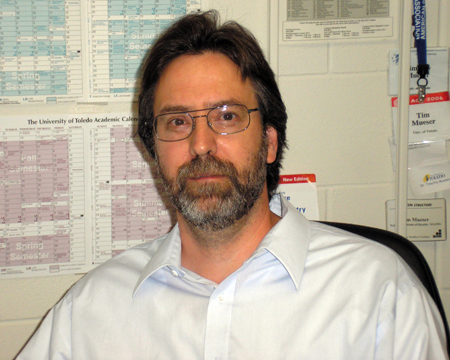Faculty: Timothy C. Mueser, Ph.D.

Professor
Email: timothy.mueser@utoledo.edu
Office: WO 4211
Phone: (419) 530-1510
Fax: (419) 530-4033
Professional Background:
B.S. Chemistry, Eureka College, 1983;
Ph.D. Chemistry, University of Nebraska-Lincoln, 1989;
Iowa Cardiovascular Center Institutional Research Fellow, University of Iowa, 1992;
NIH Postdoctoral Fellow, University of Iowa, 1993;
NIH IRTA Fellow, NIAMS National Institute of Health, 1993-1998;
NIH Senior Staff Fellow, NIAMS National Institute of Health, 1998-2000.
Publications
Advisees
Research Interests:
Biophysical chemistry and macromolecular crystallography.
Visualizing protein:protein and protein:DNA complexes using X-ray crystallography.
Analysis of PLP dependent enzymes and nucleases using neutron crystallography.
Background:
Prof. Mueser’s Ph.D dissertation research at The University of Nebraska – Lincoln
under the guidance of Prof. Lawrence J. Parkhurst involved the development of a piezo-modulated
laser excitation fluorescence polarization stopped-flow for rapid reaction studies
of protein:ligand interactions. Postdoctoral research involved single-crystal X-ray
diffraction studies of vertebrate hemoglobins conducted at the University of Iowa
– Iowa City in the laboratory of Prof. Arthur Arnone. Staff Scientist position at
the National Institutes of Health was in the laboratory of Dr. Craig Hyde who solved
the crystal structures of porcine aspartate aminotransferase (AAT) in a collaboration
with Prof. Arnone and Prof. David Metzler at Iowa State University, Ames Iowa. Craig
also solved the structure of tryptophan synthase (TS) in a collaboration with Dr.
David Davies, and Dr. Edith Miles at the National Institutes of Health, Bethesda Md.
AAT and TS are the focus of our current neutron diffraction studies of PLP dependent
enzymes. While at NIH, structural studies of the bacteriophage T4 DNA replication
system were begun in collaboration with Dr. Nancy G. Nossal, Chief, Laboratory of
Molecular and Cellular Biology, NIDDK National Institutes of Health. The structures
of T4 RNase H, a 5' to 3' exonuclease of the RAD2 family of enzymes, and the gene
59 helicase assembly protein, a structure specific DNA binding protein were completed.
The University of Toledo:
Research here continued the research on bacteriophage T4, a virus that infects bacteria,
which is well established as a model system for understanding the complex interactions
required for DNA replication, repair, and recombination. We have reported studies
on the analysis of gp59 with the gp41 helicase, the T4 RNH in complex with branched
DNA, and the gp59:gp32 complex (supported by an NSF CAREER award). A review “Structural
analysis of bacteriophage T4 DNA replication: a review in the Virology Journal series
on bacteriophage T4 and its relatives” provides an overview of this work.
Neutron Diffraction:
During a sabbatical at Oak Ridge National Labs with Dr. Paul Langan and Dr. Leighton
Coates, neutron scattering and diffraction methods were added to the research program.
Neutron diffraction allows the visualization of protons (deuterons) which are absent
in X-ray diffraction structures. The neutron diffraction structure of liganded R-state
hemoglobin allowed comparison of the protonation state of residues involved in the
Bohr effect. We have recently completed the neutron structure of AAT (Nature Comm in press) in collaboration with Dr. Andrey Kovalevsky and Dr. Jerry Parks, ORNL,
and Dr. Matthew Blakeley, ILL Grenoble. Steven Dajnowicz has been awarded a Battelle
ORNL GO! fellowship and is completing his Ph.D. dissertation research at ORNL.
Microgravity Research:
The low flux of neutron sources necessitates the need for very large (>1 mm^3) crystals.
A collaboration with Prof. Constance Schall, University of Toledo Dept. of Chem. Eng.,
investigates the effect of protein solubility on crystallization. These studies led
to crystallization trials on the International Space Station delivered by SpaceX 4.
Our current research, funded by CASIS/NASA, is to use microgravity to improve crystallization
growth for neutron diffraction. Our next flight will include hydrogenated and perdeuterated
PLP dependent enzymes, AAT and TS, and the T4 RNH and T4RNH:gp32 complexes.


